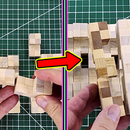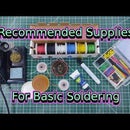Introduction: Using Solder | Soldering Basics
If you're learning how to work on electronics, you'll definitely need to learn how to solder. I'm making a series of Instructables about some Soldering Basics to discuss different aspects of soldering. In this Instructable I'm focusing on the very basics of using solder and applying it. In this Instructable I'm demonstrating with some wires, but this information can also be used when applying solder to circuits.
If you're interested in learning about some other aspects of soldering, you can check out the other Instructables in my Soldering Basics Series:
- Using Solder (This one)
- Using Flux (Click Here)
- Soldering Wires to Wires (Click Here)
- Soldering Through Hole Components (Click Here)
- Soldering Surface Mount Components (Click Here)
- Basic Desoldering (Click Here)
- Using Perfboard (Click Here)
- Required Tools and Supplies for Basic Soldering (Click Here)
- Recommended Tools for Basic Soldering (Click Here)
- Recommended Supplies for Basic Soldering (Coming Soon!)
I'm open to adding more topics to this series over time so if you have any suggestions, leave a comment and let me know. Also, if you have any tips to share, or if I get some of my info wrong, please let me know. I want to make sure this Instructable is as accurate and helpful as possible.
If you would like to see a video version of this Instructable, you can see that here: https://youtu.be/-qk-ulz05J8
Supplies
Here is what I used:
Step 1: Basic Application
The photos that I'm including for the first few steps will include some (bad) drawings. Hopefully they're good enough to demostrate what I'm trying to explain.
With your soldering iron hot, put it on the back side of the part to be soldered. Bring the solder into contact with the wire, opposite from the iron. If you look at the cross-section picture here, you can see that the wire is touching the iron at one small point. This makes it take a long time for the wire to heat up enough to melt the solder, so see the next step for a tip to speed that up.
Step 2: Helpful Tip
Before adding solder to the wire, add a little bit of solder to the iron. Now put the wire into that little bit of solder. This will give the wire more area to contact the heat, helping to melt the solder faster when you touch it to the wire. That's the basic process, so now I'll demonstrate with some actual wires and explain a few other things.
Step 3: This Isn't Bonding Very Well
Without any solder on the iron, the solder isn't melting quickly. After adding some solder to the iron, the wire heats up enough to melt the solder very quickly. Now I can rub the solder onto the wire to coat it. But notice that it's not coating the wire effectively. The melted solder is clumping up and looks like it has a weird skin on it. It's just not bonding to the wire effectively.
Step 4: Solid Wire Solder (Avoid This)
The reason is because of the type of solder. More specifically, this is solid wire solder. Although it's not very common for electronics, you may still encounter it. You can see that when it melts, it has that weird skin coating it. That skin is an oxide layer, and it blocks the solder from bonding to the copper.
Step 5: Rosin Core Solder (Use This)
The type of solder that you want to use is rosin core solder. From a glance it looks the same, but when you look closer you can see that it appears to be hollow. The center is filled with some flux. When this solder melts it burns the flux, and that flux prevents it from forming the oxide skin. You also get smoke coming from the solder as the flux burns. (Avoid breathing the smoke, if possible!)
Step 6: Using Rosin Core Solder
When using this solder, it's still helpful to put some solder onto the iron first. It still collects up when you use a lot, but it doesn't have that oxide layer. When you move it around it actually coats the wire instead of just building up on top of it. My next Instructable will be about flux and I will also talk more about that oxide layer.
Another thing to remember; If this solder is heated up long enough to burn off the flux, it will start to form an oxide layer on the melted solder.
Step 7: Soldering Thicker Wires/Parts
Another factor that can affect soldering is the size of the part that you're trying to solder. In these photos I have a thicker wire than before. Obviously we know that it helps to put solder onto the iron first, but even then it doesn't melt the solder right away. The reason is because bigger parts take longer to heat up. After about a minute I got impatient and decided to melt a bit of solder to bridge it onto the wire. Sometimes this can help transfer the heat a little bit faster.
Step 8: And That's It!
And that's the basic info needed for applying solder! Now all you need to do is practice.
As a spoiler for my "Using Flux" Instructable, you can see in this last photo the solder has that oxide film and is mostly just built up onto the wire and looking kind of crusty. I was using that no-flux solder here as a reminder that flux is necessary. In my next Instructable of this series I'll show you how to use flux to fix this "oxide skin" situation if you come across it. So make sure you check that Instructable out!
Here are the other Instructables for my Soldering Basics Series:











